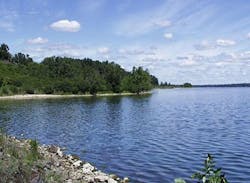EPA will provide $20,200,000 to Onondaga Countyfor planning, design and construction to upgrade the Syracuse-Metro sewage treatment plant to provide better disinfection treatment to improve the water quality of Onondaga Lake as part of a total $186M investment. Onondaga Lake: Photo courtesy U.S. EPA.
NEW YORK, NY, AUG 17, 2017 -- The U.S. Environmental Protection Agency announced it has awarded nearly $186 million to New York State to help finance water infrastructure projects that are essential to protecting public health and the environment. The funds will primarily be used to upgrade wastewater and drinking water systems throughout the state.
In 2017, EPA awarded $146,343,000 to the New York Clean Water State Revolving Fund (CWSRF), administrated by the New York State Department of Environmental Conservation (NYSDEC) and its financing program, the Environmental Facilities Corporation (NYSEFC). This award plus a 20% state match and repayments from prior CWSRF loans, combined with interest earnings and bond issuances, will enable the financing of up to $830 million of clean water infrastructure projects in New York.
Also in 2017, EPA awarded $39,559,000 to the New York Drinking Water State Revolving Fund (DWSRF), administrated by NYDOH and its financing program, the NYSEFC. This award, plus a 20% state match and repayments from prior DWSRF loans, combined with interest earnings and bond issuances, will enable the financing of up to $350 million of drinking water projects in New York.
"Providing funds directly to New York emphasizes the importance of partnering with states to help address their unique and critical environmental challenges," said EPA Administrator Pruitt. "President Trump has made updating our nation's infrastructure a priority, and this grant demonstrates EPA's commitment to carrying out improvements. These types of investments help empower states to protect their natural resources, and grow their economy while solving real environmental problems in local communities."
The Clean Water State Revolving Fund program provides low-interest loans and principal forgiveness for the construction of water quality protection infrastructure projects to make improvements to wastewater treatment systems and control pollution from stormwater runoff, which will protect New York's lakes, rivers and the Atlantic Ocean.
Examples of the types of projects on the State's CWSRF Intended Use Plan are:
- $20,200,000 to Onondaga County for planning, design and construction to upgrade the Syracuse-Metro sewage treatment plant to provide better disinfection treatment to improve the water quality of Onondaga Lake;
- $12,934,000 to the Town of Poughkeepsie for planning, design and construction for upgrades and expansion of the Arlington sewage treatment plant to improve water quality in the Hudson River;
- $56,472,804 to Suffolk County to construct a new ocean outfall at the Bergen Point wastewater treatment plant to a barrier island. This will provide resiliency and mitigate damage from future storm events and will improve water quality in the Atlantic Ocean.
The Drinking Water State Revolving Fund program provides low-interest loans and principal forgiveness for the construction of infrastructure projects and for the administration of small system technical assistance, source water protection, capacity development, and operator certification. These projects and practices of the DWSRF program will protect people's health by reducing exposure to contaminants in drinking water.
Examples of the types of projects on the State's DWSRF Intended Use Plan are:
- $7,200,000 to theCity of Rochester to place a cover over the Highland Reservoir and upgrade its water storage;
- $1,400,000 to the Ossining Water Department (Westchester County) to upgrade its water treatment plant;
- $1,394,550 to Altamont Village (Albany County) for new wells, disinfection and a transmission main.
Since 1989, the EPA has awarded $6.2 billion to New York State through these programs, which, along with the other program funds, has enabled New York State to finance $20 billion in projects.



